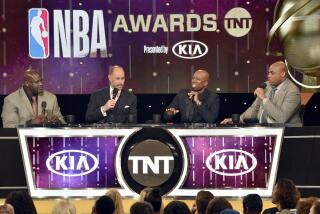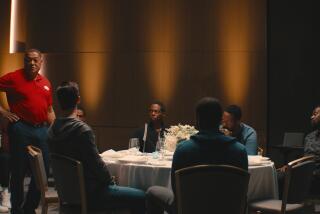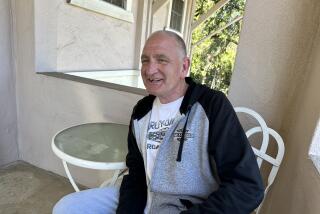NBA Drug Users Get Minds Back in Shape at Van Nuys Center
- Share via
The ASAP Treatment Center in Van Nuys is the National Basketball Assn.’s version of the Betty Ford Center, an exclusive “rehab and detox” facility for players who want to kick a habit--and practice their slams at the same time.
“We’re the only drug-treatment center in the country with NBA-approved breakaway backboards,” says Dr. David Lewis, ASAP founder and director.
Since Lewis signed a contract with the NBA 4 years ago, 14 former and current players, among them Orlando Woolridge of the Lakers and Quintin Dailey of the Clippers, have checked into the private facility. Average stay: 45 to 48 days. Cost: $450 to $500 a day, most of it covered by the player’s medical insurance.
Besides Woolridge and Dailey, former patients still in the NBA are Walter Davis of Denver, William Bedford of Detroit, John Lucas of Seattle, Roy Tarpley of Dallas and Chris Washburn of Atlanta.
Utah’s John Drew, Houston’s Lewis Lloyd and Mitchell Wiggins, and New Jersey’s Micheal Ray Richardson, who are no longer in the league, went through the program. Houston’s Dirk Minniefield is currently a patient, as are former players Duane Washington of New Jersey and David Thompson of Denver.
“It was a tough adjustment for the first couple of weeks, but when you get used to the regimen, the place is a home away from home,” said Woolridge, who stayed at the facility for 51 days early in 1988.
Like other celebrity-studded treatment facilities, ASAP tries to camouflage its institutional aspects and create a laid-back, friendly environment. Plenty of plants. Soothing murals. Therapists in blue jeans. Family visits. Open, friendly dialogue with the staff. Everything geared to ease a patient’s predicament and keep him from wanting to run back to the real world.
“You get bored from time to time,” said Woolridge, who played ball with Bedford during his stay. “There’s other things you want to be doing and can’t--like shopping. But it’s not like you can just leave.”
Indeed, quitting the program would result in suspension without pay by the NBA.
ASAP is at Van Nuys Community Hospital, occupying the east wing as well as six bungalows on the grounds. Players stay in the east wing for the first 25 to 30 days of treatment, sleeping in hospital-like rooms without TV or telephone, and then move to the homier bungalows, which have kitchens and living rooms. Food is standard hospital fare.
The white stucco bungalows, with their orange tile roofs and lap pool in the courtyard, would appear to make up an ordinary, middle-income apartment complex were it not for an occasional Mercedes in the garage and the expensive talent on the undersized basketball court. Lewis, a self-described “exercise nut,” prescribes a daily dose of basketball as part of every player’s treatment.
“Physical exercise is helpful in recovery,” Lewis said. “It is a perfectly good addiction.”
Players go through detoxification without such drugs as Valium or methadone, Lewis said, and receive “12-step therapy,” the procedure established by Alcoholics Anonymous in which the addict must first admit he’s powerless over the drug. Among the other steps are a “spiritual awakening” and helping others get off drugs.
Daily sessions with counselors--all of them recovering addicts--are designed to resolve the “root conflict,” such as low self-esteem, that led to the player’s addiction, Lewis said.
Said Dailey: “I learned why I went to drugs and how to deal with life, and I found out a lot about myself. It’s OK to be Quintin. I don’t have to be the basketball player all the time.”
A typical NBA player at the facility awakens at 6:30 a.m.--earlier than other patients--in order to start a rigorous workout that includes lap swimming, playing volleyball, riding stationary bikes, working at weight machines and, of course, playing basketball with the NBA-approved backboards. Players get about 90 minutes of court time a day, often drafting other patients for games of H-O-R-S-E. If more than one player is there, they play one on one.
“I was probably in the best condition of my life when I came out,” said Dailey, who was a patient twice for a total of 75 days about 3 years ago.
The players’ extensive workouts--they can be as long as 3 hours a day--is the only difference between their rehabilitation program and those of the other patients, who don’t exercise nearly as long. All patients are put on a rigid schedule, which includes several hours of counseling and group therapy and nightly AA or Cocaine Anonymous meetings in the Van Nuys area. The facility has a patient-staff ratio of 2 to 1 and can accommodate as many as 30 adults.
Players get only about 90 minutes of free time a day and have to be in bed by 11:30 p.m. Dailey said he used the time to practice interaction.
“One of my problems had been that I never talked to people,” he said. “So during free time, I watched TV and talked with everybody. It made me able to relax around people.”
Surrounding players with other addicts is a key part of therapy. It gives them a sense of fellowship, Lewis said, “so they don’t feel they’re out there all by themselves. There is something very powerful about a fellowship of people who have had the same problems and can go to that fellowship for strength and support.”
In the AA tradition, an addict is never considered cured. After-care is continuous and lifelong, with players required to attend AA-type meetings in their hometowns and to see local counselors recommended by ASAP.
Lewis said that of the 14 NBA players treated or under treatment by ASAP, most are doing well, although Wiggins, Lloyd and Washington are currently banned from the league. Richardson, once banned, has been cleared to rejoin the NBA but has decided to play in Europe.
“We think our anti-drug program is working,” said Gary Bettman, NBA vice president and general counsel.
And it’s working, Bettman said, thanks to Lewis and the league’s tough drug policy. If NBA security forces catch a player using cocaine, as Wiggins was caught, or if a player is arrested for cocaine possession, as Washington was, he is banned from the league for at least 2 years.
The NBA, though, needs more than just suspicion to test a player for drugs. The league has to gather enough evidence to convince the players’ union that there is reasonable cause for a urinalysis. If the union agrees, the evidence is then presented to an arbiter--usually a retired judge--who makes the final decision on whether to test a player.
Players who voluntarily turn themselves in for treatment are given what Lewis calls “3 strikes and you’re out.” The first time a player goes in for treatment, he gets his NBA salary while he is under Lewis’ care. The second time, he isn’t paid. If a player goes in a third time, he is banned for at least 2 years.
“It’s a pretty strong deterrent,” Woolridge said.
When a player goes to his coach or general manager for help, he is considered in a crisis situation, and strict procedures are followed. The team is instructed to call Lewis, who then sends one of his staff members to get the player and accompany him to Van Nuys.
“Once they get to us, they’re addicted,” Lewis said.
Under the NBA’s agreement with the players’ union, cocaine and heroin are the only substances for which a player can be banned. Marijuana and alcohol dependency and steroid use are not covered. Thirteen of the 14 players involved in treatment at ASAP have been cocaine addicts, Lewis says. Thompson, who checked in voluntarily last week, reportedly was admitted for an alcohol problem.
Once a player returns to NBA action after treatment, he must submit to drug tests two or three times a week. If he then tests positive for cocaine, he gets a minimum 2-year ban and must once again complete treatment before applying for reinstatement.
Dailey says he doesn’t mind being tested.
“It protects me,” he said. “If I’m late to practice because of a traffic jam, I don’t want people thinking the wrong thing.”
Players who finish the treatment don’t get an automatic pass back to the NBA. Lewis, the NBA’s medical director and the only expert the league uses to gauge the readiness of its addicts, must give the OK. And he isn’t obligated to return a player to action immediately. After-care can go on for months. Bedford, for example, was admitted to the center before last season’s playoffs and is still not playing.
“We function autonomously--there’s no pressure from coaches or general managers,” Lewis said. “For players to get back, they have to successfully complete the program. We want some things to happen--they have to see sobriety as a personal way of life, including being part of an AA program. If those things don’t happen, the NBA’s position is: We’re not paying you $400,000 a year to go out and kill yourself. We want them to remain drug-free.”
Lewis’ involvement with the league includes intervention training and education. Twice a year since 1984, he and his staff have visited each NBA team.
Said Joanne Barron, ASAP vice president: “We try to tell them that if one player has a problem, it affects the whole team. We talk about drug abuse as a family problem.”
At first, however, the players resisted.
“They were sure we were bad guys who could tell by looking in their eyes whether they were using drugs,” Lewis said.
But the training and the “just say no” sentiment in the country have paid off with a cleaner NBA, says therapist Rex Fine, ASAP director of outpatients.
“The players have gotten very healthy and very educated and sophisticated,” he said. “Ten years ago, if a guy used drugs, ‘it’s his business.’ Today, ‘it’s affecting our chances of winning.’ It is no longer cool to do drugs.”
To Lewis, drugs were never cool. A slender, bearded man of 42, he was 60 pounds heavier when he played football for the University of Missouri in the late 1960s. But even as a student in the hippie era, he never used drugs, Lewis said.
“I was always straight,” he said. “I made up my mind in junior high to become a doctor.”
After graduating from the University of Colorado Medical School in 1973, he joined the Air Force and became chief of the mental health department at the Air Force Academy. Lewis left the service as a major and in 1979 started the ASAP program, which he calls a clone of the Air Force in-patient treatment program.
ASAP originally was an acronym for Adult Substance Abuse Program, but since the center now also treats children, Lewis says, the letters no longer stand for anything.
The tie-in with the NBA occurred 6 years ago, Lewis said.
“We had some patients who knew people in the NBA and told the league about us.”
The NBA investigated him and ASAP and decided to use the Van Nuys facility as its only treatment center. Players can’t go elsewhere, even on their own.
“What the NBA wants is the centralization of treatment and after-care,” Lewis said.
Once a player is released from the Van Nuys facility, his family, teammates, ASAP staffers and other recovering addicts serve as a support group, keeping him clean and sober and away from what Woolridge calls “slippery situations.” But players, Woolridge said, sometimes don’t get a lot of support from basketball fans.
“I still hear ignorant things from the stands, like fans calling me a bum,” Woolridge said.
To stifle his darker impulses now, Woolridge has only to think back to his first few days in Van Nuys. He was watching the NBA “Game of the Week” on television when he saw his picture flashed on the screen and heard the announcers talk about his “drug problem.” At that moment, he says, he knew he would never again put his career in jeopardy.
“I don’t want to repeat the program,” he said. “I have too much to lose.”
More to Read
All things Lakers, all the time.
Get all the Lakers news you need in Dan Woike's weekly newsletter.
You may occasionally receive promotional content from the Los Angeles Times.








